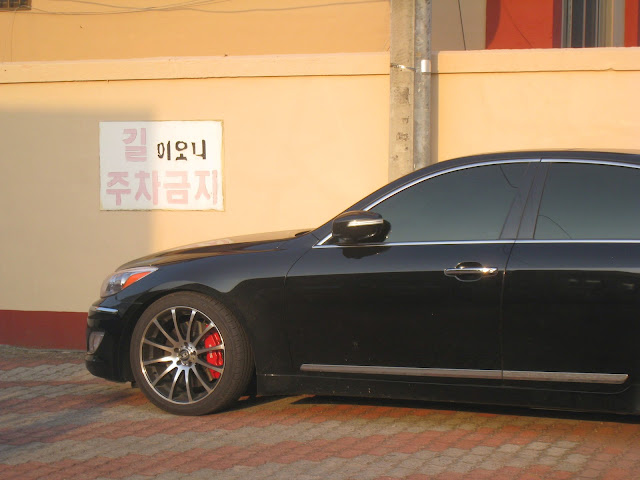Actually, nothing is wrong with the Korean alphabet
per se. It's great. But there is a problem with the way the letters of the alphabet are presented and learned. It's the result of some changes in pronunciation that have happened over the 500+ years since the alphabet was invented.
Here's a poster of the alphabet the way it is usually presented, with 24 letters: 14 for consonants and 10 for vowels.
 |
| I've placed a bright red vertical line after the last consonant and before the last vowel. |
The ordering is quite systematic. All the consonant letters come first, then all the vowel letters. Within each group there is also a logical ordering. Little kids learn the alphabet by reciting these 24 letters in order.
Here's an example of systematicity in letter design. If a vowel sign has an extra short line attached to it, that signifies a preceding "y" sound. Below are the vowel letters in the same order seen on the poster, along with their transcriptions. As you can see, they are paired together in groups with and without "y".
ㅏ
a ㅑ
ya
ㅓ
eo ㅕ
yeo ("uh" and "yuh")
ㅗ
o ㅛ
yo
ㅜ
u ㅠ
yu
ㅡ
eu (close to the vowel sound in English "put")
ㅣ
i
These are the basic vowel letters in the alphabet, but they are not the only vowel
sounds that can occur in a Korean syllable. Most other vowel sounds are actually combinations of vowels—diphthongs—and are written with two vowel letters each. This is why they are not considered basic and don't appear on the chart. You don't need to learn them as part of the alphabet, because they are just letter combinations.
For example, the word for 'ear' is
gwi. It has two vowel sounds in it,
u followed by
i. It's written 귀, i.e. ㄱ (
g) plus ㅜ plus ㅣ. The vowel combination
wi ㅟ isn't considered part of the alphabet because it is transparently composed of ㅜ plus ㅣ
and it is pronounced as
u plus
i. (Try saying "ui" fast and notice that it turns into "wi".)
Okay, so far so good. But something interesting happened to Korean pronunciation a few hundred years ago. In 15th-century Korean there were two diphthongs
ay and
eoy, pronounced like the vowels in the English words
buy and
boy, respectively. The first one,
ay, is an
a sound followed by an
i sound, so was written ㅏ plus ㅣ, i.e. ㅐ. The second one,
eoy, is
eo ("uh") followed by
i, so was written ㅓ plus ㅣ, i.e. ㅔ. Just as with
wi, these were transparent combinations, so they weren't learned as basic letters of the alphabet.
But then pronunciation changed. The sound
ay coalesced into a single vowel
ae (as in English
met), and the sound
eoy coalesced into a single vowel
e (as in English
mate).* But their spelled forms didn't change. So while
graphically ㅐ and ㅔ look like sequences of two vowels, they are
pronounced as single vowels. That means that you can't understand how to pronounce them by looking at their graphic structure the way you can with
wi ㅟ. You just have to learn them as is:
ㅔ
e
ㅐ
ae
Well, think of poor little 3-year-old Tek. He's been looking at this poster in his room every day, learning the letters, singing them at school, and he's also learned how to write his name in Korean. And one day he says, looking at the chart, "Where is ㅐ?" That's the vowel in his name. And it's not on the poster!
In my opinion, the "alphabet" should have been reformed long ago with the addition of ㅐ and ㅔas basic letters. In our household we have taken a small step in that direction by amending our poster.
 |
| The alphabet chart, now supplemented with one of the two missing basic vowel sounds. |
* For almost all Korean speakers these two vowels have now merged, but they are kept distinct in spelling. Kind of like the way "w" and "wh" sounds have merged for most speakers of American English, but we still keep them distinct in spelling.

















































